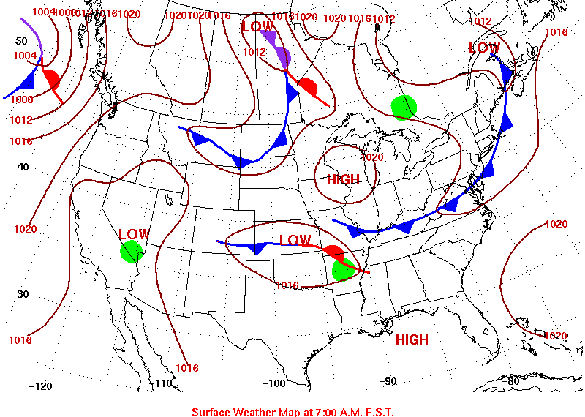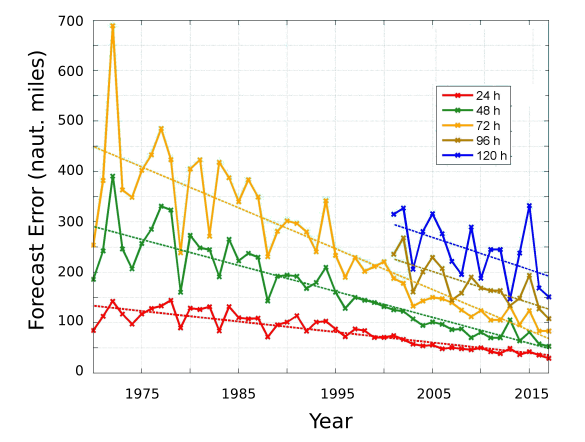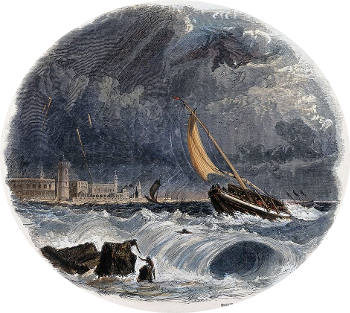Weather Forecasting
April 8, 2019
Weather was a foremost topic of the many
jokes I learned in my
childhood. The following are the most memorable:
* Where does a snowman keep his money?
In a snow bank.
* What do you get when you cross a snowman and a vampire?
Frostbite.
* When do you realize that it's raining cats and dogs?
When you step in a poodle.

Medieval children "getting medieval." Winter weather in Upstate New York is extreme, but I enjoyed the snow when I was a child. Now, the snow-covered driveways and roadways bring fewer winter delights. (Detail of folio 12r, Codex 103, "Book of Hours" (Dijon, 1524), via Wikimedia Commons.)
The
origin of the unusual expression, "raining cats and dogs," is unknown, but
conjectures about its possible origin are given in an article on the
United States Library of Congress website.[1] Its first recorded use was in the
15th century, and its origin is sometimes associated with
Odin, the
Norse god of
storms, being depicted with dogs and
wolves, the
symbols of
wind. That's a rather weak conjecture since there are no cats involved in that depiction. Knowing the 15th century origin of the expression and the
classical education of that time, I
place my bets with the
Greek expression, κατα δοξα (kata doxa),
against belief.
Early man must have been amazed that something
invisible like the wind could exert a
force. This must have fueled a belief in invisible being such as
ghosts. The minor
Greek god,
Aeolus, was known as the keeper of the winds. There's a saying that everyone talks about the weather, but no one does anything about it. Primitive man did try to do something about it by performing
rituals, like
rain dances.
Weather forecasting has been practiced for more than 2,500 years, albeit not too successfully.
Aristotle (384 BC - 322 BC) gave some forecasting tips in his 350 BC
Meteorologica,[2] as did
Theophrastus (c.371 - c.287 BC) in his Book of Signs (De Signis).[3] In later times we've had the old
nautical adage, "
Red skies at night, sailors' delight. Red skies in morning, sailors take warning," that I mentioned in an
earlier article (Red Skies at Night..., April 25, 2014).
The
invention of
atmospheric sensing instruments like the
thermometer and the
barometer, when finally coupled with
reliable telecommunication, offered a
scientific means of understanding and
forecasting the weather. This finally gave the ability to map
air masses over large
areas, such as the
contiguous United States (see figure), that enabled improved weather forecasting.

Weather map of the contiguous United States for July 19, 2003. I selected this date since that was when I observed an exceptional episode of a radio propagation phenomenon called tropospheric ducting on the FM radio band. From 10:30 AM to 3:30 PM I was able to detect, at my Northern New Jersey location, WYYX, Bonifay, Florida on 97.7 MHz as if it were a local station. (National Oceanic and Atmospheric Administration map. Click for larger image.)
Computers have advanced many scientific disciplines, and that includes weather forecasting using
numerical methods of weather prediction. The first significant
milestone in this regard was a forecasting program implemented on the
ENIAC computer in 1950.[4] This forecast happened in real time; that is, it took an entire day to forecast the day's weather. It was realized that faster computers would give weather forecasts for future days. Of course, this hope was predicated on the development of adequate
atmospheric models. On the 100th
anniversary of the
American Meteorological Society, a short perspective on advances in weather prediction has been
published in
Science by
geoscientists from
Pennsylvania State University (University Park, Pennsylvania) and the
Massachusetts Institute of Technology (Cambridge, Massachusetts).[5]
As stated in this article, the
economic benefit of weather forecasting is 3-10 times its
cost.[5] In a 2009 study, the value of weather forecasting derived from from $3.4 billion in
public expenditure and $1.7 billion in
private expenditures is $31.5 billion to US
households.[5]
Adults in the US access weather forecasts 300 billion times per year, and
geographically specific weather information is available instantly on
smartphones and other devices.[5] I get my forecasts from the
National Weather Service and
Weather Underground, generally from a
desktop computer.
Many parts of the world are now experiencing high
wildfire activity; and, as we glean from
news reports, the
developing world is quite vulnerable to
weather disasters. The number of people living in
flood-prone areas has more than doubled over the past 30 years.[5] The
World Bank reports that upgrades to national
meteorological and
hydrological services of about $2 billion, with annual expenditures of about $500 million, could save 23,000 lives per year and provide many billions of dollars annually in economic benefits.[5]
The
accuracy of weather forecasting is improving through improved observations, better models, and better
data acquisition and
data management.[5] Accuracy of predictions has continued to improve for such weather events as
Hurricanes,
blizzards,
flash floods,
hailstorms, and
tornadoes.[5] Presently, 72-hour predictions of hurricane tracks are more accurate than 24-hour forecasts were 40 years ago (see figure).[5] Today's 5-day forecast is as accurate as a 1-day forecast was in 1980, and forecasts up to 10 days provide useful information.[5-6]

Advances in hurricane prediction. These are the track errors of Atlantic Basin Tropical Storms and Hurricanes from 1970 - 2017, with least-squares trend lines superimposed. (Graph from the National Hurricane Center, National Oceanic and Atmospheric Administration, reformatted using Inkscape. Click for larger image.)
Such progress has been made despite
spatially incomplete and uncertain
data. There are also limits imposed by
sensitivity to initial conditions, a principle known as the
butterfly effect.[5] Such sensitivity to initial conditions can be mitigated by using a large number of computer forecasts starting from slightly different initial states.[5] Forecasts are aided by known
seasonal and
annual cycles, such as the
Madden-Julian Oscillation that moves
eastwards around the
tropics over 30-90 days.[5]
Weather forecasting is important to
renewable energy, since forecasting of weather-related effects such as
sunlight and wind availability is needed to balance
electrical grids.[5] Increased use of
unmanned aerial vehicles for monitoring hurricanes and other
extreme weather events have great potential.[5] Improvements in
high-speed computing offer the opportunity for improved weather forecasts.[5] While newer
technologies are expensive,
governments should resist putting weather forecasts behind
paywalls.[5]

Monsoons at sea.
The dynamic imagery of clouds and extreme weather have been an inspiration to artists.
(Colored wood engraving by C. Whymper, a Wellcome Trust image, Photo V0025039, via Wikimedia Commons
![]()
References:
- "What is the origin of the phrase 'it's raining cats and dogs?'," Library of Congress Website.
- Aristotle, "Meteorology," E. W. Webster, Trans., The Internet Classics Archive at mit.edu.
- Theophrastus, "Concerning Weather Signs," from "Enquiry into Plants," from Bill Thayer's Penelope Website at the University of Chicago.
- G.W. Platzman, "The ENIAC Computations of 1950: Gateway to Numerical Weather Prediction," Bulletin of the American Meteorological Society, vol. 60, no. 4 (April, 1979), pp.302-312. An open Access PDF File can be found at this URL.
- Richard B. Alley, Kerry A. Emanuel, and Fuqing Zhang, "Perspective - Advances in Weather Prediction," Science, vol. 363, no. 6425 (January 25, 2019), pp. 342-344, DOI: 10.1126/science.aav7274.
- Peter Bauer, Alan Thorpe, and Gilbert Brunet, "The quiet revolution of numerical weather prediction
," Nature
, vol. 525 (September 2, 2015), https://doi.org/10.1038/nature14956.
Linked Keywords: Weather; joke; childhood; snowman; money; snow; bank (geography); hybrid (biology); cross; vampire; frostbite; rain; raining; cat; dog; poodle; Middle Ages; Medieval; child; children; getting medieval; winter; weather; Upstate New York; driveway; roadway; joy; delight; Wikimedia Commons; etymology; origin; conjecture; United States Library of Congress; website; 15th century; Odin<; Norse mythology; Norse god; storm; wolf; wolves; symbols; wind; Classics; classical education; gambling; place bets; Greek language; Greek expression; Doxa; belief; prehistory; early man; invisibility; invisible; force; ghost; Greek mythological figure; Greek god; Aeolus (Odyssey); ritual; rainmaking (ritual); rain dance; weather forecasting; Aristotle (384 BC - 322 BC); Meteorology (Aristotle); Meteorologica; Theophrastus (c.371 - c.287 BC); nautical; adage; Red skies at night, sailors' delight. Red skies in morning, sailors take warning; invention; atmosphere of Earth; atmospheric; sensor; sensing instrument; thermometer; barometer; electrical telegraph; reliable telecommunication; science; scientific; weather forecasting; air mass; area; contiguous United States; US weather map for July 19, 2003; weather map; radio propagation; phenomenon; tropospheric ducting; United States FM radio band; Morris County, New Jersey; Northern New Jersey; WYYX; Bonifay, Florida; MHz; National Oceanic and Atmospheric Administration; computer; numerical methods of weather prediction; milestone (project management); ENIAC; atmospheric model; anniversary; American Meteorological Society; scientific literature; publish; Science (journal); earth science; geoscientist; Pennsylvania State University (University Park, Pennsylvania); Massachusetts Institute of Technology (Cambridge, Massachusetts); economic; cost; public expenditure; private expenditure; household; adult; geography; geographical; smartphone; National Weather Service; Weather Underground; desktop computer; wildfire; news report; developing country; developing world; meteorological disaster; weather disaster; flood; World Bank; meteorology; meteorological; hydrology; hydrological; accuracy; data acquisition; data management; tropical cyclone; hurricane; blizzard; flash flood; hailstorm; tornado; tropical cyclone seasonal forecasting; hurricane prediction; track; Atlantic Ocean; Atlantic Basin; Atlantic hurricane; least-squares; National Hurricane Center; Inkscape; spatial; data; sensitivity to initial conditions; butterfly effect; season; seasonal; annual; periodic function; cycle; Madden-Julian Oscillation; east; eastward; tropics; renewable energy; sunlight; electrical grid; unmanned aerial vehicle; extreme weather; supercomputer; high-speed computing; technology; government; paywall; monsoon; sea; cloud; artistic inspiration; artist; origin of the phrase 'it's raining cats and dogs?'.